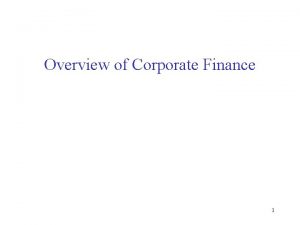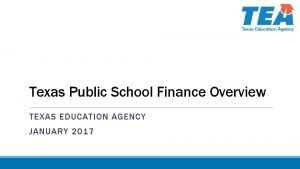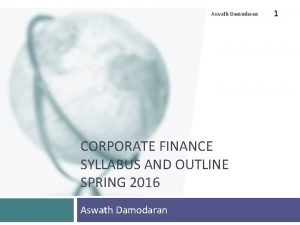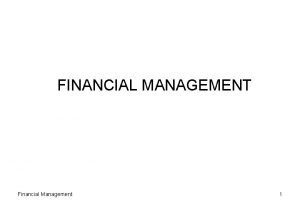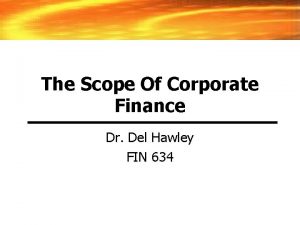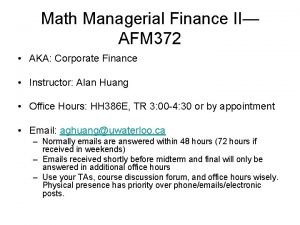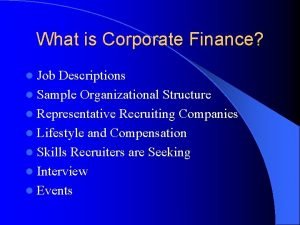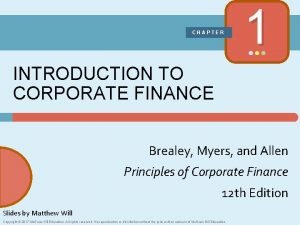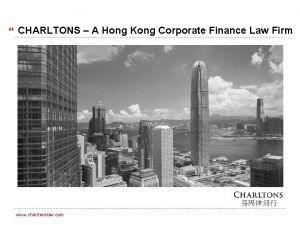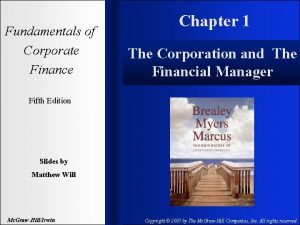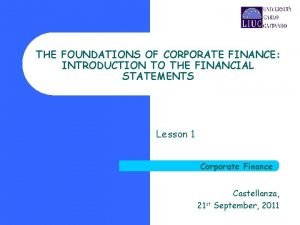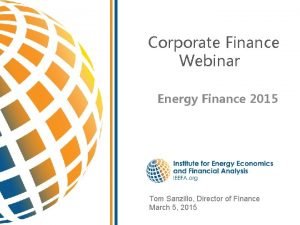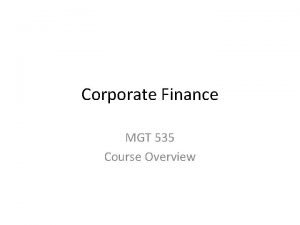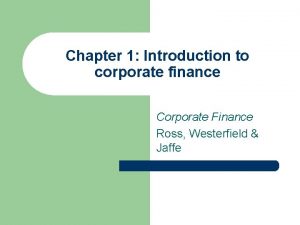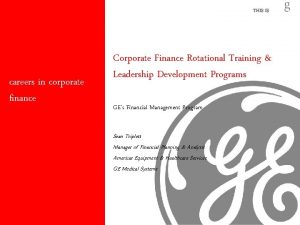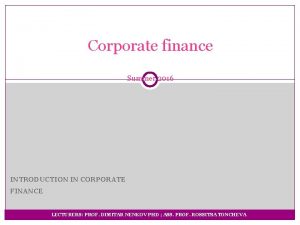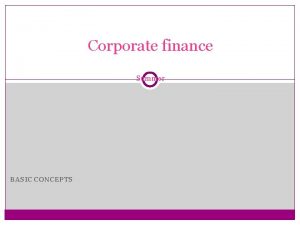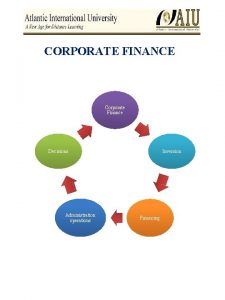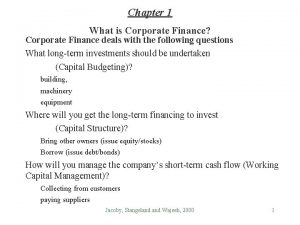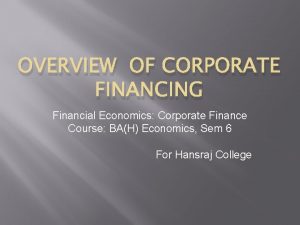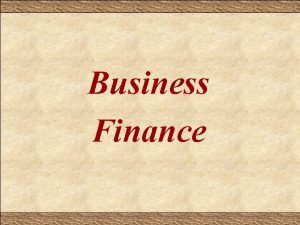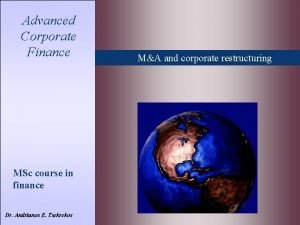Course Overview Finance what is it Corporate Finance



















- Slides: 19

Course Overview Finance: what is it? Corporate Finance Corporations Money and capital markets Financial Markets: Banks, Stock Exchanges Investments Investors 1 -1

If you are an investor n In investments we seek to value securities and maximize the value of our portfolio (Valuation of bonds and stocks). 1 -2

If you are the CEO of an industrial company n In corporate finance we are concerned with making decisions that enhance firm value. n n you can make your company more valuable by choosing “better” projects (capital budgeting decision) you can make your company more valuable by changing the mixture of your financing, i. e. the ratio of debt to equity (capital structure decision) 1 -3

Financial decisions n Capital budgeting decisions (how to invest money) n n n Real capital investments Mergers; acquisitions Capital structure decisions (how to raise and return money) n n n Equity Debt Distribution (Dividend, share repurchase) 1 -4

Balance-Sheet of the Firm The Capital Budgeting Decision Current Liabilities Current Assets Long-Term Debt Fixed Assets 1 Tangible 2 Intangible What long-term investments should the firm engage in? Shareholders’ Equity 1 -5

Balance-Sheet of the Firm The Capital Structure Decision Current Liabilities Current Assets Fixed Assets 1 Tangible 2 Intangible How can the firm raise the money for the required investments? Long-Term Debt Shareholders’ Equity 1 -6

CHAPTER 1 Introduction to Financial Management n n n Forms of Businesses Goals of the Corporation Conflicts Between Managers and Shareholders 1 -7

Alternative Forms of Business Organization n Proprietorship Partnership Corporation 1 -8

Proprietorships & Partnerships n Advantages n n Ease of formation Subject to few regulations No corporate income taxes Disadvantages n n n Difficult to raise capital Unlimited liability Limited life 1 -9

Corporation n Advantages n n n Unlimited life Easy transfer of ownership Limited liability Ease of raising capital Disadvantages n n Double taxation Cost of set-up and report filing 1 -10

A Comparison of Partnership and Corporations Corporation Partnership Liquidity Shares can easily be exchanged. Subject to substantial restrictions. Voting Rights Usually each share gets one vote Taxation Double General Partner is in charge; limited partners may have some voting rights. Partners pay taxes on distributions. Formation difficult easy Liability Limited liability Continuity Perpetual life General partners may have unlimited liability. Limited partners enjoy limited liability. Limited life 1 -11

What should be the financial Goal of a company? n n Maximizing revenue, cut cost, secure market share? The primary financial goal is shareholder wealth maximization, which (generally) translates to maximizing stock price. 1 -12

Is stock price maximization the same as profit maximization? n n No, despite a generally high correlation amongst stock price, EPS, and cash flow. Some actions may cause an increase in earnings, yet cause the stock price to decrease (and vice versa). E. g. , cut R&D. 1 -13

Factors that affect stock price n n n Projected cash flows to shareholders Timing of the cash flow stream Riskiness of the cash flows 1 -14

Agency relationships n n An agency relationship exists whenever a principal hires an agent to act on their behalf. Within a corporation, agency relationships exist between: n Shareholders and managers n Shareholders and creditors 1 -15

Shareholders versus Managers n n Managers are naturally inclined to act in their own best interests (Shirking, empire building, corporate jets, entrenchment). To mitigate the problem: n n Bonus, stock options Direct intervention by shareholders The threat of firing The threat of takeover 1 -16

Shareholders versus Creditors n n Shareholders (through managers) could take actions to maximize stock price that are detrimental to creditors. For example: taking too risky projects. (Are you willing to lend money to someone who gamble a lot? ) 1 -17

n n When the outcome is very good, shareholders enjoy the fruit. When the outcome is bad, shareholders are protected by limited liability. E. g. , can get away by declaring bankruptcy. 1 -18

1 -19
 Examples of agency problems
Examples of agency problems Corporate finance overview
Corporate finance overview Objective of corporate governance
Objective of corporate governance Texas public school finance overview
Texas public school finance overview Foundations in personal finance chapter 1
Foundations in personal finance chapter 1 Texas public school finance overview
Texas public school finance overview Overview of personal finance chapter 1
Overview of personal finance chapter 1 Corporate finance syllabus
Corporate finance syllabus Modern financial theory
Modern financial theory Fundamentals of corporate finance canadian edition
Fundamentals of corporate finance canadian edition Scope of corporate finance
Scope of corporate finance Corporate finance ii
Corporate finance ii Corporate finance job scope
Corporate finance job scope Chapter 1 introduction to corporate finance
Chapter 1 introduction to corporate finance Corporate finance law firm hong kong
Corporate finance law firm hong kong Fundamentals of corporate finance, chapter 1
Fundamentals of corporate finance, chapter 1 Corporate finance tenth edition
Corporate finance tenth edition Fundamentals of corporate finance, chapter 1
Fundamentals of corporate finance, chapter 1 Foundations of corporate finance
Foundations of corporate finance Corporate finance webinar
Corporate finance webinar
